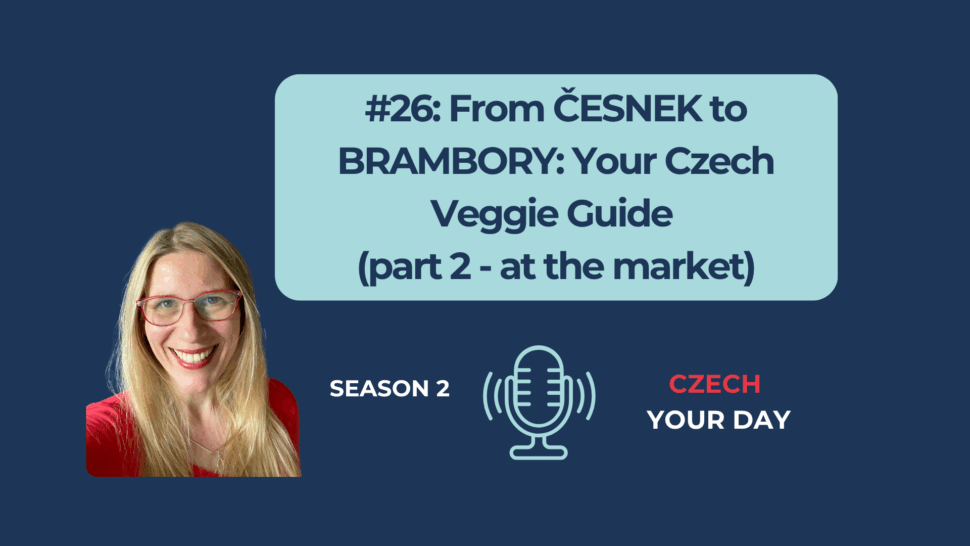Your Czech Veggie Guide – Part 2 (S02/E26 – daily podcast CZECH YOUR DAY)

THIS WEEK’S TOPIC: NA TRHU/AT THE MARKET
THE TRANSCRIPT/HANDOUT IS DOWN BELOW
This week, we’re diving into the vibrant and flavorful topic of buying fruit and vegetables at the market. If you haven’t already, be sure to check out the previous episodes to get the most out of this week (you can find the links at the bottom of this page).
- Česnek
- Garlic
- Pórek
- Leek
- Cibule
- Onion
- Brambory
- Potatoes
- Jedna brambora
- One potato
Now, I’ll draft out the sentences about each vegetable in both Czech and English, followed by the full blog post body with headers.
(ten) Česnek (Garlic)
- Má charakteristické aroma, má ostrou chuť, používá se hodně například v italské kuchyni. Je palice česneku a stroužek česneku. Palice česneku, to je celý česnek. A stroužek česneku je jeden dílek, jedna část.
- English:
- It has a characteristic aroma, a sharp taste, and is used a lot, for example, in Italian cuisine. There is a bulb of garlic and a clove of garlic. A bulb of garlic is the whole garlic, and a clove of garlic is one section, one piece.“
(ten) Pórek (Leek)
- Nahoře je zelený a dole je bílý. Používá se do polévek, do slaných koláčů nebo do pomazánek. Můžeš ho použít místo cibule. Pórek je hodně zdravý.
- English:
- It is green at the top and white at the bottom. It is used in soups, savory pies, or spreads. You can use it instead of onions. Leek is very healthy.
(ta) Cibule (Onion)
- V obchodě můžeš koupit žlutou, červenou nebo bílou cibuli. Také existuje šalotka. Cibule se v české kuchyni dává hodně do omáček, do polévek, do pomazánek nebo do salátu.
- English:
- In the shop, you can buy yellow, red, or white onions. Shallots also exist. In Czech cuisine, onions are often added to sauces, soups, spreads, or a salad.
(ty) Brambory (Potatoes)
- Jedna brambora. Z brambor můžeš udělat například bramborovou kaši, bramborové knedlíky, hranolky, bramboráky, bramborové placky, bramborový salát. Češi milují brambory. Obvykle mají brambory hnědou nebo červenou slupku, kterou musíš oškrábat škrabkou. Brambory jsou uvnitř žluté.“
- English:
- One potato. From potatoes, you can make, for example, mashed potatoes, potato dumplings, fries, potato pancakes, potato cakes, and potato salad. Czechs love potatoes. Potatoes usually have brown or red skin, which you need to peel with a peeler. Inside, potatoes are yellow.
Blog Post Title:
Blog Post Body:
Introduction Welcome to another enriching session of „Czech Your Day,“ the daily podcast that takes you through the fascinating world of the Czech language. learning experience. Let’s work on building your Czech vocabulary in a natural, fun, and playful way!
Learning Czech with Vegetables
Garlic (Česnek) Garlic is known for its characteristic aroma and sharp taste. It’s a staple in many cuisines, including Italian. In Czech, you have a „palice česneku,“ which is a whole bulb, and a „stroužek česneku,“ which refers to a single clove.
Leek (Pórek) The leek boasts a green top and a white bottom. It’s commonly used in soups, savory pies, and spreads, and it can be a healthy substitute for onions.
Onion (Cibule) In Czech shops, you can find yellow, red, and white onions, as well as shallots. Onions are essential in Czech cuisine, frequently used in sauces, soups, spreads, and salads, enriching the flavors of many dishes.
Potatoes (Brambory) Potatoes are versatile favorites. They are used to prepare a variety of dishes like mashed potatoes, dumplings, fries, pancakes, cakes, and salads. Czechs adore potatoes, typically peeling their brown or red skins to reveal the yellow flesh inside.









